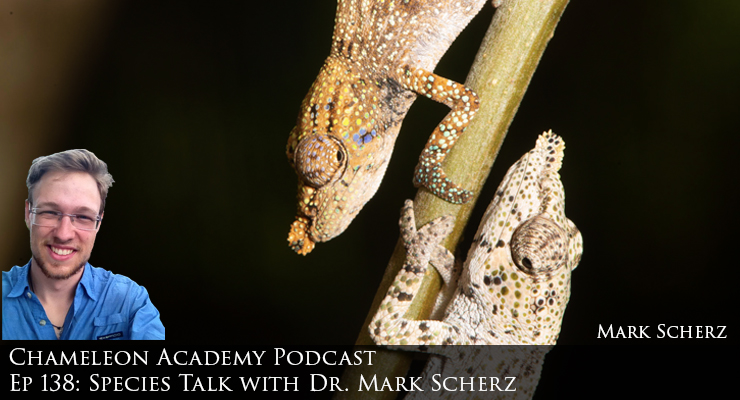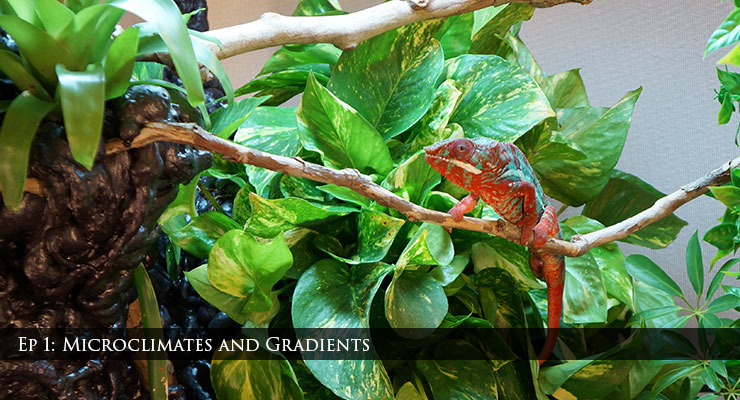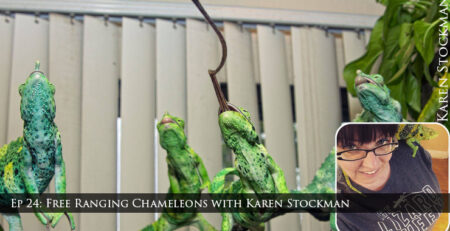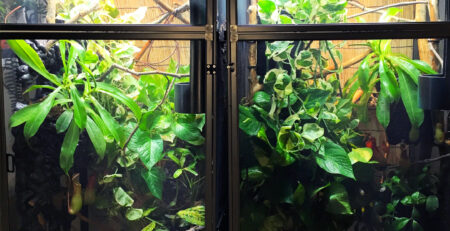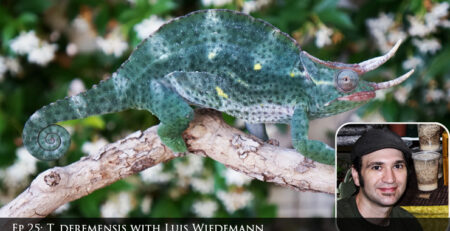Ep 214: Discussions on Chameleon Behaviors
Listen Here!
Chameleon behavior is a window into what is going on in their lives. It is one of the ways they communicate with us if we have learned the language to hear what they are saying. Today I go over the basics of what behaviors mean. We will talk about the difference between a behavior that is showing an emotional issue and a behavior that is showing a medical condition.
Links from the episode
I am now doing a second podcast called the Reptile Entrepreneur. If you have ever thought about starting a business in the reptile community then this is the show for you. I go over everything from manufacturing to breeding and various business topics. So far, I have talked to Josh Dovenbarger who is a bearded dragon breeder and David Brahms who makes perches for the Green Tree Python community with 3D printing technology. You are probably familiar with Todd Goode who came on and talked about overseas manufacturing. Next Monday you’ll hear from Richard Clarke who is a patent attorney who gives us an introduction to how the patent process works. And soon I’ll be talking about starting a YouTube channel or even a podcast of your own. If you would like to be more deeply involved in the reptile community then I invite you to check out the Reptile Entrepreneur on any podcast app, YouTube, or, best of all, at reptileentrepreneur.com which will have links to everything!
Transcript (More or Less)
Introduction
Good morning, Chameleon wranglers! Today we are going to continue our exploration of chameleon behavior. We will talk about the difference between a behavior that is showing an emotional issue and a behavior that is showing a medical condition. This is somewhat part two of the discussion we started last episode. In that one we talked about being able to pick up on changes in behavior that indicated that something was off. We talked about increasing our sensitivity to what they are telling us. And this is an important skill because chameleons will hide any weakness. But if we learn the subtleties of their behavior language we can develop that skill. So, let’s talk about behavior and what it means!
The catalog of chameleon behaviors is extensive. So I have ot break it up into chunks. This episode cannot cover everything. I have selected to go over behaviors that could give you an indication of a possible medical condition. So, I won’t talk about the one handed chameleon salute or swiveling behind a branch or things like that. I’ll talk about things I would like you to be skilled in looking out for to save their life because they indicate something possibly serious.
At a basic high level, behaviors that show discontent are an increase in activity. While medical conditions are a decrease in activity. Makes sense, right? So, all we need to know is what the chameleon baseline is for activity and we can start to get a feel for what is above and below this. The natural state of a chameleon is staying in one place and only moving for heat, UVB, to get out of heat or UVB, or to get to where the food is. And if all those environmental conditions would ebb and flow perfectly and food would traipse on by on a regular basis, chameleons would be happy to sit in a safe and secure spot all day and night. Remember that chameleons are always on the look out for predators. Birds, snakes, larger reptiles, climbing mammals, even larger invertebrates are always looking for a meal themselves. Just the act of moving puts the chameleon in danger. This is why they do that jerky back and forth movement when they walk. They are trying to look like something other than an animal that is good to eat. They figure they’ll take their chance with the leaf eaters. So, anytime they decide to go bask in the open to heat up or move to a better hunting location they are acutely aware that they are increasing their risk of being eaten. Not only by being more exposed, but simply by the act of moving.
What this means for us is that chameleon movement means something. It is a form of communication in itself. And we can get clues as to what is going on in their minds by watching when they move.
The question we keepers have to answer is whether the movement is because of a normal behavior, emotional need, or medical need. So, let’s look at those three things.
First, normal behaviors.
Before I go into what is normal chameleon behavior, keep in mind that chameleons are living beings and each is an individual. Just like us humans. So once I go over a generalized behavior list for a day in a chameleon’s life you have to account for individual differences in your specific chameleon. Every chameleon will have nuances. When 99% of the species acts a certain way it is valid to say that that is a characteristic of the species. But be ready for someone who has one of those 1% to burst onto social media proudly boasting that he has proven all the experts wrong! And then whole groups decide they are enlightened because they hold onto this obscure characteristic to redefine the species. Yes, some experienced people are done learning new things, but many of us use our experience to realize that there will always be that 1% that don’t fit our human need to define things definitively. And that the existence of the 1% does not negate the truth that the overwhelming number fall into the 99%. I am highlighting this because it is so easy to get confused on social media with every expert fighting for attention and using whatever methods are necessary to show how special they are.
One more point and huge danger area. Movement is 100% under control of the chameleon’s conscious brain. This means it is a behavior and behaviors and habits are constantly affected by the environment. Example, say your chameleon goes to bask every morning to warm up. One morning, while doing this, your chameleon notices that your cat has figured out how to climb onto the plant pot tower by the cage and has learned your chameleon’s habits and now makes it a point to be hidden in the houseplants waiting for your chameleon to come up and bask. All it takes is for this to happen a few times and your cat to do something, like lunge, to scare your chameleon and you, oblivious to all of this, are left to wonder why your chameleon doesn’t want to bask anymore. How do you defend against what you don’t know you are missing? That is a tough one. But we have to be very careful what assumptions we make about any judgement. Watch a lot of Sherlock Holmes movies. That’s what I do.
But this also comes to play in other ways. The more comfortable a chameleon gets in life the less they will need to find security. If they are comfortable with their cage they may stop hiding in the foliage to sleep. This is a normal progression in stable chameleon households. So you need to apply modifications to the general chameleon behavior I am presenting before you apply it to your unique situation. Use this as a foundation to build your own personal standard behavior set.
Here is the danger. You need to remove your layer of emotions that you project. If you are projecting human emotions onto your chameleon you are muddying the waters and you won’t be able to see clearly. Yes, all living things have variations on the same emotional set. The warning sign that you are stepping into the realm of projection is when you are convinced you have tapped into an emotion that has no relevance to a chameleon’s survival in the wild. And since people who have manufactured that special connection to a chameleon will have turned my message off long ago I can only say this to people who are trying to sort through all the information out there and figure out what is real. I know we want to love our pets and have them love us. And that is okay when it is all in our heads. But when those desires result in us justifying husbandry, caging, and handling choices, then our human emotional interpretations are compromising the quality of our overall husbandry.
The standard chameleon behavior is to sleep in a secure location. This means hidden in thick foliage on thin branches. In South Africa I found a Chamaeleo dilepis sleeping deep inside a big bush that had more than inch long thorns all over. There was blood spilt getting that one out for the sake of a blurry photograph. You can see pictures of them at the ends of long thin branches, presumably in a way to be able to detect snakes coming along the branch to get them. In your cage it would take the form of sleeping on the branches behind the plants. This is why I recommend lots of horizontal perching branches behind a thick middle layer of foliage. You want that security option to be available to them whether they end up using it or not.
They wake up upon lights on and make their way to the basking area where they warm up. Once warmed up they will leave the basking area and find where they want to hang out during the day. Often this is back inside the foliage where they feel safe. They will always be on the look out for food and predators. In the evening you may find them back out. This is looking for food before settling into their choice for sleeping spot. Kind of a simple life. And that is the way they like it.
Chameleons are intelligent enough to determine schedule patterns. If you feed them at the same time during the day you will find them waiting for you. If you feed them in the same spot every time you will find them waiting there for you. So you can establish this simple interaction. And you can take advantage of this. At the same feeding time you can start feeding time off by offering a treat by hand. Maybe a superworm or dubia or anything else that is different from your standard fare. Once hunger inspires them to take it from your hand you give them their regular crickets in your feeder run cup. This trains them that your fingers bring something good. The more gregarious chameleons will start getting their tongue shooting ready when you come into the room whether you have anything in your hands or not.
Another scheduled behavior you will see is that they will learn when the lights will go off. In the wild, they get into their sleeping spot before the sun sets. They want to be ready for darkness when it comes. In captivity, we tend to have sudden darkness when the lights go off. Eventually we will have dimming lights as standard husbandry equipment, but, for now, chameleons will figure out when lights out time is and go to their sleep spot an hour before. This is the one time where it is okay for chameleons to have their eyes closed while the lights are on. If they close their eyes a certain amount of time before lights go out every day then this is a sleeping behavior and not a medical condition you need to worry about. Each chameleon does this differently. I have heard of chameleons doing this 30 minutes before lights out and one extreme case was two hours. But they are just following some internal switch and that switch is working off of unnatural signals so give them some leeway.
Emotional needs
There are two emotional needs that will drive behavior. Security and mating season. These manifest themselves as restlessness. A very common question from keepers is why their chameleon does laps around the inside of the cage. They crawl across the sides, up and down, and upside down across the top. This is a behavior of a chameleon that wants to be someplace else. Usually it is because their cage is too small or they don’t have enough plant cover to feel safe. But it can also be that their cage is down on the ground and they want to be higher or else they aren’t getting enough heat. There is something that is not right.
The most common misinterpretation is that the chameleon wants to come out and play with you. And this has led to many stressed out chameleons that just want to find a better place to sleep and end up having to play hand over hand run every time. So you think you have a loving chameleon that wants to play and your chameleon is insecure and stressed. A massive miscommunication. This is further complicated by the fact that occasionally, there truly is a chameleon that seems to want to come out and be with humans. This chameleon will be content in their cage, but then crawl onto your arm when you are doing maintenance, crawl to your shoulder, and then hang with you for a spell. Maybe eat a roach you offer from your hands. And then show no interest in going back in his cage. But once you get him back in his cage he happily settles back in. I presently have two chameleons just like this. And me, in all my cynicism and constant efforts to challenge the notion that they want to be out with me, has to cry uncle and accept that they just don’t fear me and have decided that food comes when I do so they want to hang out on me and see what appears. The problem is that the existence of these individuals does not mean that every chameleon can be this way. And it definitely does not mean that every person who says their chameleon loves them has a handle on reality. Do you know how hard it is to see these chameleon whisperers posting pictures of them with a stressed chameleon talking about how in-tune they are with nature? Remember there is a wide range of variation in individuals. So, it is possible that your chameleon is one of these outliers. It is not probable and you should never expect that you can look for and find one. Because if you interpret incorrectly your chameleon will suffer. But they do happen. And, that doesn’t mean that all of us saying that chameleons are not handleable are wrong. I have two that buck the trend, but I would be doing the community a huge disservice if I did anything that allowed someone to expect that friendly is what they would find when they got a chameleon.
Mating Season is a special case. You may notice your male chameleon suddenly becoming restless out of nowhere and you have no idea what has gotten into him. It is possible that the mating season bug has bitten him and he is now looking for a female. In this case he will be driven and there really isn’t much you can do to stop him searching. The immediate question is whether you should get him a mate and I would caution you against volunteering yourself to be a chameleon parent to 20 to 30 babies because of this. I know it sounds fun in the moment, but there are far reaching consequences to the decisions you make…and now I am sounding like I am giving a talk to my teenagers. This will subside. I had a couple Jackson’s Chameleon males who would do this every Spring. I found they would especially do this if they could see other males and females in the area. The only problem is if they are damaging themselves by this constant activity. If they are in the typical screen cage and you are worried about injury on the screen would can line the inside with trellis or something which allows them to climb on something beside the screen itself. For me, they would do this for a week or two and then go back to normal.
Females may become restless and walk the bottom of the cage if they have eggs they want to lay. Although you should be expecting this if you introduced a male 30 days ago, some females, depending on circumstances, will develop unfertile clutches and, having never intended to mate them or even know what a gravid female looks like, you may be surprised by this. If your female chameleon suddenly becomes restless and crawling around the bottom of the cage then consider whether a laying bin would be appropriate. If she appears to have gained weight faster than you would have expected then this is a good thing to consider.
Changes in behavior can also signal nutritional or medical needs
The most common behavior that we see that sends up a red flag is a chameleon with closed eyes during the day. Any lethargy or closed eyes will send experienced chameleon keepers into a frenzied multi-pronged rehabilitation mission. The only exception was mentioned before and that is getting ready for sleep. We take this seriously because it indicates an internal distress and once it gets to the point where it is showing itself as closed eyes and lethargy we know it is far along. This is so serious that I dedicated the last episode to early warning skills.
Now, eyes closed could be other things as well such as physical trauma such as a scratch on the eye or debris in the eye turret or nutritional such as a vitamin A deficiency. So it is time for a vet visit to confirm in order to make sure your treatment is appropriate and effective.
Here are a handful of other behaviors we see that tells us something is off.
Eating soil. Geophagia is the action of eating soil and this is usually thought to be because of a deficiency of some mineral in the diet. It gets hard to treat this behavior if you already are giving calcium every feeding and multi-vitamin/mineral supplements every week or two. If you aren’t, modifying your supplementation routine is the best place to start. But sometimes we cannot figure out what is driving them to eat soil. I always say that the best solution is to figure out what stops the behavior instead of removing the soil to prevent the behavior, but I would also suggest removing the soil if they continue to eat the soil. On one hand, eating soil isn’t inherently dangerous, but with the potting soils we use with fertilizer balls and the possibility of impaction I actively discourage and prevent the eating of soil while I figure out what they are missing in their diet. Impaction is where they are not able to pass feces due to a blockage. This blockage could be because of a parasite load out of control or it could be because what they tried to eat clogged up the pipes. Soil doesn’t digest and break down so you can see where eventually there could very well be something that doesn’t go out the back door smoothly. Any dehydration will exacerbate the situation as well.
Hunger strikes. A chameleon refusing to eat can be serious or it can be that they are just full. If they are not eating because of a medical condition like impaction or feeling horrible you are going to see other signs as well such as lethargy and eyes closed. But the most common cause of a hunger strike is that the chameleon is simply full. Chameleons really don’t use a lot of calories during the day. And we tend to feed them very well in captivity. We feed them so well that they are getting too many calories in some cases. When this happens they get pickier and picker as to what they eat. They are getting picky because they aren’t eating for survival. They are eating for pleasure and entertainment. It is the same as us eating dinner, being full, but making an exception for ice cream. Get a chameleon stuffed with cricket to where they couldn’t eat another bite and then get a shiny green bottlefly into their cage and you will see them totally ignore that they can’t eat anymore to get the prized flying green thing. If your chameleon is healthy, active, and not eating then simply skip feeding for three or four days. When you come back they should be ready to have their next meal. Don’t worry, chameleons can go a long time without eating. Three or four days is nothing for them. It makes them hungry, but is not dangerous at all. Just when you start feeding again, feed less than you used to.
Drinking Water. What? What is the problem with drinking water? That is what they are suppose to do! Well, I present this for your consideration. Chameleons will normally not have opportunities to drink water during the day in their native ranges. Sure, a rain storm provides it, but in the dry season rain storms could be few and far between. They are drinking dew in the morning and then getting moisture from their food. So why are they gulping water from your mister in mid afternoon? Well, this is a sign of dehydration. A chameleon that is enthusiastically drinking is dehydrated. They are usually reserved and you rarely see them drink the dew on the leave from your morning misting. Now, this is a new approach that is meant to match the hydration cycle from their native lands. This is opposite of the standard chameleon husbandry of the last few decades so this is controversial. I am not going to fight anyone on it. Take a look at the reasoning on both sides and you make your own decisions. You can go to the show notes reptileentrepreneur.com for some research links.
And finally, strange body movements. If your chameleon seems to be flailing its limbs around for no discernable reason or is grabbing its tail or other limbs then you are seeing signs that are common to a case of Metabolic Bone Disease. This is where a calcium deficiency causes limbs to be misshapen and can mess with control of those limbs. What you are seeing is a result of a nutritional disorder that will eventually kill your chameleon so all your concern is justified. This is time to get to a vet for some quick calcium in your chameleon and a husbandry review to make sure you have calcium in the diet and sufficient UVB shining down. And if you already have a UVB light then it is time to dig deeper and see if that UVB light really is doing the job.
Those are my chosen top behaviors run into by chameleon keepers that have significance. Of course, there are many others. On the Chameleonacademy.com website I have a whole section about behaviors trying to catalog it all for new keepers to be able to have a quick guide. Check it out if you would like to see what resources are available to you to dig deeper into this subject. And, if you have come to the end of this episode and want to dig deeper into understanding your chameleon you are seeing the top tier of keepers. Maybe you are just starting off and have a lot to learn. But you are on the path and are taking the steps forward. Don’t let the enormity of what there is to know intimidate you. To truly be experienced in the chameleon world it takes years simply to observe and live through the basic life stages. Get a juvenile panther chameleon and it will be at least two years before you are able to say you have witnessed the basics of their life stages. So, you have time. Lots of time. I encourage you not to get caught up in the accelerated pace you find on social media where you feel that pressure to memorize everything and start being the expert in month’s time. Where people are giving advice on raising babies before they have even hatched eggs. This is all a façade. This is the land of caresheets written by people who haven’t even seen a lifecycle of the species. It is all borrowed off other people’s work. So, my advice is to stay away from that rat race. Look at this as a five to ten year pilgrimage where you will absorb everything, try it out, and truly make it your own before bothering pretending you know what you are talking about. This podcast is the deepest collection of chameleon knowledge from around the world that exists. There is literally no other resource that comes close to exposing you to the input and perspective from so many experts around the world. If you listen to one episode a week you will only be halfway through your five year plan by time you get to the end. Of course, I keep making them so maybe there will be enough to fill up the rest of that five year plan. But my point is that you have time. Don’t rush it. This is a wonderful corner of the natural world and, so far, there appears to be no end to what we can learn about chameleons and the natural world through our love for chameleons. So, relax…and take it little step by little step. Before you know it all of this will not only make sense, but you’ll be there alongside me working on the next steps for our community.
As a reminder, this podcast has a website home base where I have taken the chameleon knowledge combined together and made a substantial resource to study their husbandry. I was going to use the word “comprehensive”, but there is so much more that I have to do. I only need 72 hours a day to get it all done. Though there is something invigorating knowing that I can work on it for the next 30 years of my life and the action item list will still hardly have a dent in it when I finally pass it on to the next Chameleon Academy Headmaster. That day is decades away, but I know I will be busy every day until that point. Thank you for walking the path with me and joining me on this adventure. And now it is time for me to get working on the next episode because there is still so much more to do!









